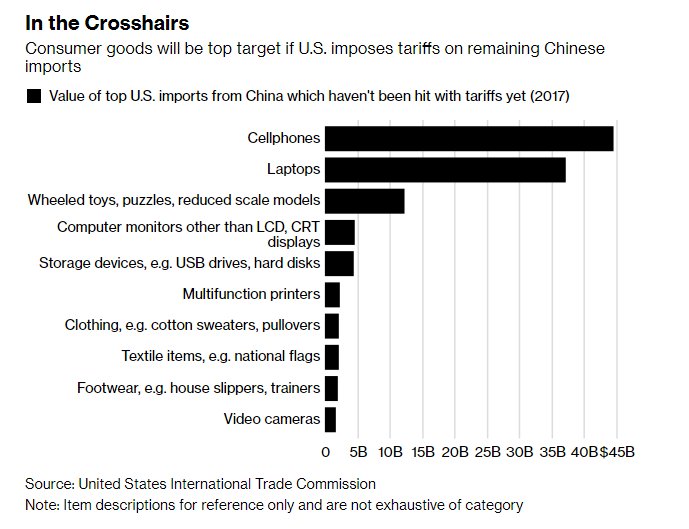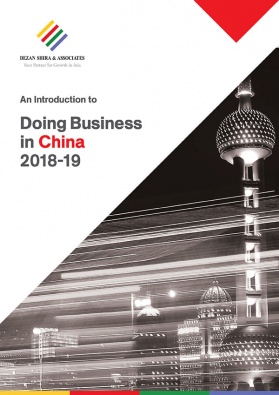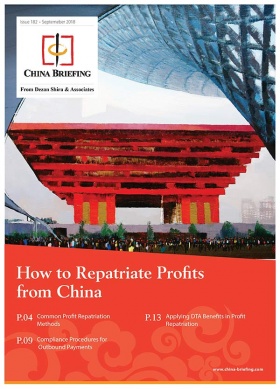Trump’s Tariff War: Who Will Prevail – the US or China?
Op/Ed by Chris Devonshire-Ellis
US President Donald Trump has threatened another round of tariffs upon China – this time on a further US $267 billion of products, which will impact upon consumer items such as iPhones. This is in addition to the 25 percent in tariffs due to be imposed on Chinese imports to the US that is set to take place from January 1, 2019, a little over a month from now.
This additional tariff threat would, if implemented, impact on Chinese consumer goods as follows:

Consequently, there is much to anticipate at the meeting between Trump and Chinese President Xi Jinping at the upcoming G20 meeting in Buenos Aries on Friday.
Trump’s most recent threat is a precursor to that, and is intended to show Xi that the US is quite prepared to play hardball, even at the risk of rising prices for China-manufactured products being sold in the US. He has said that he will “not back down“.
Many US analysts believe Trump and Xi will hammer out a deal. Yet for China, and its allies, this also represents a chance to stand up to what is increasingly being perceived as US bullying, and take serious steps to implement the process of gradually reducing the influence of the US upon global trade. Although this would mean short-term economic pain, medium and longer term this could be a positive thing for China’s own development – it seeks to remodel global affairs as it sees fit as opposed to being permanently subservient to Washington DC.
In fact, Washington DC may well have overplayed its sanctions card and the ‘hard landing’ of the Chinese economy this implies. The US president and his foreign policy team would be well advised that China remembers well the sacrifices it made during China’s own civil war and subsequent upheavals. They would do well to remember that the Communist Party of China, within its own ideology, is very familiar with the path of “permanent revolution“, and its leaders, unlike those in the West, have all been educated in this doctrine. Coined by Marx, more closely associated with Trotsky, then later adopted by Mao, the theory of permanent revolution essentially states that the revolution does not come to an end after one or other political gain has been achieved, but develops further, and the limits for it are the establishment of socialist society.These words essentially mean that in order to create and benefit a socialist society (read: a prosperous Chinese society), struggle is a natural state of affairs and is part of a continuing development process. That justification is also part of what has kept North Korea as an independent state. Signs of it are also apparent in contemporary Russia, whose economy is under heavy sanctions from the US, yet has been remodeled and is rebuilding so as not to rely on trade with the US, and after four years of downturn, it is poised to show GDP growth this year. In the interim Russia has been changing its trade patterns to be more Asia focused and has simply turned to making products it used to import. It remains to be seen whether US trade analysts are familiar with the longer term impact short term measures such as sanctions can usher in. But based on historical cases, probably not a lot.
The problem Trump and Washington DC face in dealing with Xi is that they have no background in China. Although China is bound up to a large degree in the global financial system, and a trade war would hurt the Chinese economy, it does not carry the same stakes for Xi as it does Trump. Trump has an election coming up in less than two years. When faced with that timeframe, Trump’s political decision to do battle with Xi starts to look a little uneven.In some ways, China may even welcome a trade war. It is one it can survive, and will have the impact of loosening the trade influence of Washington DC. Moving away from US influence is something Beijing wants, and it will have been taking stock of how Moscow has been able to deal with the trade sanctions placed upon it in 2014.
Having spent 25 years based in China, and more recently a great deal of time in Russia since the sanctions began, I have an eye on both economies and how they behave and react to significant change. In Russia, where I have been developing an early bird Dezan Shira & Asscociates presence, keeping an eye upon and educating ourselves about Russian trade and economic developments, in addition to researching the overland impact of China’s Belt and Road Initiative, it has been interesting to note how the Russian economy now sees the US as an “untrustworthy” trade partner, and has responded by remodeling its economy towards Asia. Yet despite short-term pain, the Russian economy is recovering. It moved into higher GDP growth than either the EU or US was able to achieve last year, and has effectively de-coupled its entire economy from the US.
Trump should be wary of this in his dealings with Xi. Tariffs on Chinese goods are just sanctions under a less evocative title, and the Russian experience shows that economies can be stronger than anticipated and adapt. If the trade war erupts, China will merely tell its citizens to buy local and sit it out, while blaming Washington DC. But it’s the longer term repercussions that really count.China wishes to rebalance its trade and be less reliant upon the US. The development and investment into the Belt and Road Initiative and the nations which are part of that can, in time, partially replace the US as a major trade partner. As I pointed out two years ago, Chinese outbound investment is going to Eurasia, not to the US. The Belt and Road is a Beijing initiative, and Beijing can exert control of trade and development throughout the Belt and Road nations in a manner it cannot with Washington DC. It is a statement in fact that China cannot compete with Washington DC under the current global trade structures. Instead, it is remodeling and asserting influence upon parts of the world to better suit its own objectives rather than those of the US. The Belt and Road, after all, is a China instigated initiative. A side effect of that is to reduce dependence on the US. No wonder Washington DC is so critical of the concept.
Beijing also wishes to reduce reliance upon the US dollar, seeing as it has been used as a trade weapon by Washington DC, most recently against Russia, Iran and Turkey, all of whose currencies have tanked this year. The result? Those same nations have implemented a “Foreign Trade Action Plan” to eliminate the US dollar in trade between them. These are not small economies. Russia has also gone two steps further. As lead partner in the Eurasian Economic Union, it has de-dollarized intra-union trade by 70 percent in 2018. The Eurasian Economic Union is a US $5 trillion economy whose intra-union trade volumes have been growing at rates of 38 percent. The US has effectively cut off its nose to spite its face; there will be no US dollar trade growth in Eurasia.
Together with China, seeing how US sanctions cut Iran off from the SWIFT international banking network, Russia has been developing its Mir Card payments infrastructure system just as China has been rapidly expanding UnionPay. Given time, it is not unfeasible to suggest that Beijing and Moscow will work together, possibly with European support, to develop an alternative payments system and gradually de-couple from the US controlled global banking system.Ushering in a trade war with China therefore suits Beijing to some extent as it will speed up the reforms in global trade that China wants to take. President Trump seems to have a shorter term view. The US should be careful what it wishes for.
China Briefing is produced by Dezan Shira & Associates, a foreign investment advisory practice with offices throughout China, Russia, India and ASEAN. Chris Devonshire-Ellis is the practice Chairman. To contact the firm, please email info@dezshira.com or visit www.dezshira.com .
- Previous Article China’s Greater Bay Area: From Factory of the World to Mega Tech Hub
- Next Article US, China Reach Trade Truce, Announce 90-day Ceasefire at G20 Summit

























